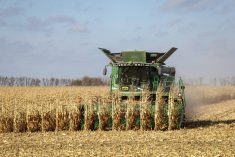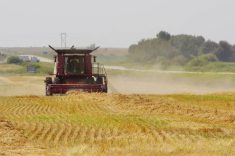Glacier FarmMedia – Without weed control, soybean growers would lose hundreds of millions of dollars according to one weed management expert.
Peter Sikkema, a professor at the University of Guelph specializing in field crop weed management estimates growers in his home province alone would lose $617 million.
His figure is based on a per-bushel price of $12.56. With current prices, the cost of inaction on weed management could be even higher.
Read Also

Still hard to predict precise fertilizer payback
Despite decades of advances, international research finds no clear answer for where and when adding nutrient will fail to boost growth.
Why it matters: Even small weeds can reduce profit. Effective control early in the growing season gives soybeans time to out-compete weeds.
The good news is that soybeans can out-compete weeds if given a head start.
“If soybeans come up on May 15 and weeds come up on June 5 … they almost have no impact on yield,” Sikkema told those at the Jan. 5 Ontario Agriculture Conference. The timing of crop and weed emergence is the critical factor, so the goal is to get soybeans up ahead of weeds.
Soybean competitiveness depends on density, soil structure and nutrient status. Grassy weeds are generally a lesser concern than broadleafs and control is more challenging in dry years.
Soybeans have good tolerance to early weed infestation, Sikkema says, particularly compared to corn. But delayed herbicide application can result in more rapid yield decline. Yield losses can start when weeds are just two inches high and the rate of loss increases with weed height.
In a low weed-density environment, for example, two-inch weeds cause a 0.3 bushel per acre loss. At eight inches, losses reach three bushels per acre.
“If you allow them to get four inches in height, it’s $11 (per acre), $27 at six inches and $48 if you let the weeds get eight inches tall,” said Sikkema, who uses historical price-per-bushel averages in his calculations.
Losses mount with high weed density, where two-inch weeds cause yield losses of 1.8 bushels per acre. The next several inches bring another bushel loss for each inch in weed height. By the time weeds are eight inches tall, yield loss is 1.5 bushels for each inch.
Two-inch-high weeds in 1,000 acres of soybeans, at $18 per bushel, can cost a grower $32,000. At eight inches, losses reach $197,000.
Profit losses of this magnitude can result from delayed herbicide application.
“I think there’s a temptation to delay the application of glyphosate until all weeds have emerged,” Sikkema says. “Early season application results in improved weed control… A small weed is easier to kill than a big weed.”
Best management strategies
Starting clean with a rain-activated herbicide helps keep the field weed-free for as long as possible.
“Any weeds that come up after the V3 stage are not going to have any impact on soybean yield,” said Sikkema, adding additional benefits such as better harvest efficiency and reduced weed seed populations are possible.
He has also observed that the top nuisance in soybeans is often Roundup Ready corn. Assure herbicide is an effective tool for removing glyphosate-tolerant corn, but new herbicide-tolerant hybrids might require products from different chemical groups. Select herbicide has proven effective in Enlist varieties, for example, particularly when combined with adjuvants like Strikelock.
“If the label recommends the addition of an adjuvant, my recommendation to you is follow the label,” said Sikkema, reiterating that adjuvants can provide good return on investment.
Adding ammonium sulphate can also be valuable, specifically for Liberty herbicide applied to kill lamb’s quarters and velvetleaf. The combination makes little difference for many other weeds, however. Adding it to glyphosate also brings no benefit. Growers should instead consider increasing their per-acre rate.
Sikkema says glyphosate rate should be adjusted based on weed pressure. Green foxtail, for example, is highly susceptible to glyphosate and can be attacked with 0.5 litres per acre. Common ragweed requires five times that amount.
The larger the weed, the more product required, he says. In the case of foxtail, a 12-inch plant requires seven times as much glyphosate as a four-inch plant.
Tank mixing can be effective against weeds, but must be approached with care. Sikkema says Dicamba hinders the effectiveness of Assure when tank mixed and other combinations have counterintuitive effects. Combining Assure and Liberty for application on Enlist E3 soybeans, for instance, brings better weed control that Assure alone.
His final observation relates to the value of a two-pass system. A second pass helps minimize soybean yield losses, lowers selection pressure and provides insurance if post-emergence application is delayed due to rain, wind, breakdowns or other challenges.
“If totally relying on a post-emergence program … you can lose money really rapidly,” said Sikkema.
“There’s an excellent return on investment in weed management in soybeans…You’re really getting a good bang for your buck with the current price of soybeans and current price of herbicide.”
– This article was originally published at Farmtario.















